Anti-Inflammatory Supplement Comparison Tool
Select Your Condition
Select Your Priority
Your Health Background
When it comes to chronic inflammation or joint discomfort, many people reach for natural supplements before trying prescription drugs. Shallaki is one of those go‑to herbs, but how does it really stack up against other options like turmeric, ginger, devil’s claw, or even a standard NSAID such as ibuprofen? This guide breaks down the science, dosage, benefits, and downsides so you can decide which route fits your lifestyle.
TL;DR - Quick Takeaways
- Shallaki (boswellic acid) targets inflammation at the enzyme level (5‑LOX) and is well‑studied for osteoarthritis.
- Turmeric (curcumin) offers broader antioxidant effects but suffers from low bioavailability unless paired with piperine.
- Ginger (gingerol) is best for nausea‑related inflammation and works quickly for muscle soreness.
- Devil’s claw (harpagoside) shows modest pain relief for low‑back pain, yet can interact with blood thinners.
- Standard NSAIDs (e.g., ibuprofen) provide the strongest immediate relief but carry gastrointestinal and cardiovascular risks with long‑term use.
What Is Shallaki?
Shallaki (also known as Boswellia serrata) is a resin extracted from the bark of the Indian frankincense tree. Its active constituents are boswellic acids, primarily acetyl‑11‑keto‑β‑boswellic acid (AKBA). Historically used in Ayurvedic medicine, modern trials focus on its ability to inhibit 5‑lipoxygenase (5‑LOX), a key enzyme in leukotriene production.
Typical oral dosage ranges from 300mg to 500mg of standardized boswellic acid extract taken two to three times daily. Most products guarantee at least 30% AKBA content, which is the fraction linked to measurable anti‑inflammatory outcomes.
How Does Boswellic Acid Work?
Boswellic acids act like a natural 5‑LOX inhibitor, reducing leukotriene synthesis that drives swelling and pain. Unlike NSAIDs that block cyclooxygenase (COX‑1/COX‑2), boswellic acids spare the protective gastric prostaglandins, lowering the risk of stomach upset. In vitro studies from 2022 show AKBA can also modulate NF‑κB signaling, further damping inflammatory cytokines such as TNF‑α and IL‑6.

Popular Alternatives at a Glance
Before diving into the side‑by‑side matrix, here’s a snapshot of the most common natural competitors.
- Turmeric - the bright yellow spice whose active compound, curcumin, blocks COX‑2 and COX‑1, and boasts strong antioxidant activity.
- Ginger - contains gingerol and shogaol, both of which lower prostaglandin synthesis and reduce muscle fatigue.
- Devil’s Claw - derived from Harpagophytum procumbens, its main active component is harpagoside, which inhibits COX‑2 and has modest analgesic effects.
- Ibuprofen - a synthetic NSAID that irreversibly blocks COX‑1/COX‑2, providing rapid pain relief but with well‑documented GI and cardiovascular side‑effects.
Detailed Comparison Table
| Attribute | Shallaki (Boswellic Acid) | Turmeric (Curcumin) | Ginger (Gingerol) | Devil’s Claw (Harpagoside) | Ibuprofen (NSAID) |
|---|---|---|---|---|---|
| Primary Mechanism | 5‑LOX inhibition, NF‑κB modulation | COX‑2 & COX‑1 inhibition, antioxidant | COX inhibition, anti‑oxidant | COX‑2 inhibition, anti‑inflammatory | COX‑1/COX‑2 blockade |
| Typical Dose | 300‑500mg standardized extract 2‑3×/day | 400‑600mg curcumin with 5‑10mg piperine 2×/day | 500‑1000mg ginger extract 2×/day | 600‑1200mg devil’s claw extract 2×/day | 200‑400mg every 4‑6h (max 1200mg/day) |
| Evidence Level (2023‑2025) | Moderate - 12 RCTs show 30‑40% pain reduction in OA | Strong - meta‑analyses confirm modest pain relief, high heterogeneity | Good - several trials for muscle soreness, nausea | Limited - few small RCTs, mixed outcomes | High - gold‑standard for acute pain |
| Onset of Action | 2‑4weeks (cumulative) | 1‑2weeks (if piperine used) | Within hours | 1‑2weeks | 30‑60minutes |
| Major Side Effects | Mild GI upset, rare skin rash | Stomach upset, possible iron‑absorption inhibition | Heartburn, mild diarrhea | Potential bleeding risk with anticoagulants | GI bleeding, kidney strain, cardiovascular risk |
| Best For | Chronic joint pain, osteoarthritis, inflammatory bowel disease | Systemic inflammation, metabolic health | Acute muscle soreness, nausea, colds | Low‑back pain, mild arthritis | Acute injury, post‑surgery pain |
How to Choose the Right Option for You
Think of the decision as a simple checklist:
- Nature of pain. If it’s chronic, low‑grade inflammation (e.g., osteoarthritis), boswellic acid shines. For sudden muscle ache after a run, ginger works faster.
- Speed vs. sustainability. NSAIDs give instant relief but aren’t meant for long‑term use. Natural extracts need weeks to build up but are gentler over months.
- Health background. People on anticoagulants should steer clear of devil’s claw. Those with ulcer history might favor boswellic acid over ibuprofen.
- Budget and availability. Standard ibuprofen is cheap, while high‑quality boswellic acid extracts can cost $30‑$45 for a month’s supply.
- Preferred format. Capsules are common for all but turmeric; many opt for a liposomal or phytosome formulation to boost absorption.
Combine, don’t stack blindly. A common protocol is 300mg boswellic acid + 500mg ginger extract taken with meals, which offers both 5‑LOX and COX inhibition without overloading the gut.
Practical Tips & Safety Notes
- Start low: If you’re new to boswellic acid, begin with 250mg daily for a week, then increase.
- Watch for interactions: Boswellic acid may enhance the effects of anticoagulants like warfarin; always check with a pharmacist.
- Enhance absorption: Fat‑soluble AKBA is best taken with a small amount of food containing healthy fats (olive oil, avocado).
- Quality matters: Look for third‑party testing (e.g., NSF, ConsumerLab) and a guaranteed AKBA percentage.
- Cycle long‑term use: After 3‑4 months, take a 2‑week break to see if symptoms persist without supplementation.

Frequently Asked Questions
Can I take Shallaki together with NSAIDs?
Yes, short‑term combination is usually safe because boswellic acid works through a different enzyme pathway (5‑LOX). However, long‑term stacking can increase GI irritation, so discuss dosing with your doctor.
How long before I feel relief from boswellic acid?
Most trials report noticeable pain reduction after 2‑4weeks of consistent dosing. Patience is key - the compound builds up in tissues over time.
Is turmeric better than Shallaki for joint pain?
Turmeric provides broader antioxidant benefits, but its COX inhibition is less potent for deep joint inflammation. If your goal is targeted relief for osteoarthritis, boswellic acid often outperforms curcumin unless you use a high‑bioavailability formulation.
Can pregnant women use Shallaki?
Safety data in pregnancy are limited. Most clinicians advise avoiding high‑dose boswellic acid during the first trimester. Always consult your obstetrician before starting any supplement.
What’s the difference between boswellic acid and AKBA?
Boswellic acid refers to a family of related acids (including β‑boswellic acid, acetyl‑β‑boswellic acid, etc.). AKBA (acetyl‑11‑keto‑β‑boswellic acid) is the most bioactive member, responsible for most of the anti‑inflammatory effects.
Whether you lean toward a herb, a spice, or a conventional pill, the right choice hinges on how your body reacts and what your health goals are. By understanding the mechanisms, dosage, and safety profile, you can craft a plan that eases pain without compromising long‑term wellbeing.







Angela Marie Hessenius
September 28, 2025 AT 08:53Having examined the comparative matrix presented in the article, one cannot help but appreciate the intricate interplay between traditional Ayurvedic wisdom and contemporary clinical inquiry, especially as it pertains to Shallaki’s multi‑faceted mechanisms of action; the inhibition of 5‑LOX not only curtails leukotriene synthesis but also dovetails elegantly with the modulation of NF‑κB pathways, a fact that resonates with the holistic paradigms championed by centuries‑old practitioners. Moreover, the pharmacokinetic considerations-particularly the lipophilic nature of AKBA and its preferential absorption alongside dietary fats-underscore the necessity of contextualizing dosage recommendations within real‑world dietary patterns, a nuance often overlooked in reductionist evaluations. The author’s inclusion of a user‑friendly interactive tool is commendable, yet the underlying data sources warrant scrutiny, given the variability in standardization across commercially available extracts; consistency in AKBA content, typically guaranteed at a minimum of 30 %, should be a non‑negotiable criterion for both clinicians and consumers alike. In parallel, the juxtaposition of Shallaki with turmeric, ginger, Devil’s Claw, and ibuprofen invites a broader discussion on bioavailability enhancers-piperine for curcumin, for instance-thereby illuminating pathways to synergistic regimens that may amplify therapeutic outcomes while mitigating adverse effects. While the discourse rightly highlights the delayed onset of benefit associated with boswellic acids, it is equally important to acknowledge patient adherence challenges, especially in populations unaccustomed to multi‑dose daily schedules; thus, formulation strategies such as sustained‑release capsules merit further exploration. Finally, the safety profile, characterized by a relatively benign gastrointestinal footprint when juxtaposed against non‑steroidal anti‑inflammatory drugs, offers a compelling argument for Shallaki’s consideration as a front‑line adjunct in chronic inflammatory states, provided that clinicians remain vigilant regarding potential interactions with anticoagulant therapy. In sum, the article serves as a robust springboard for both evidence‑based practice and future investigative endeavors, weaving together the threads of ancient botanical knowledge and modern pharmacological rigor into a cohesive tapestry that invites ongoing dialogue.
Julian Macintyre
September 29, 2025 AT 12:40The exposition herein is methodically sound yet conspicuously omits a rigorous appraisal of the statistical power underpinning the cited randomized controlled trials; without an explicit delineation of sample sizes, confidence intervals, and effect size calculations, the comparative assertions remain speculative at best. Additionally, the pharmacodynamic discourse fails to address the potential for cytochrome P450-mediated interactions, particularly in polypharmacy contexts where boswellic acid may precipitate unforeseen metabolic alterations. While the comparative table is aesthetically organized, it would benefit from a hierarchical weighting algorithm that quantifies the relative importance of onset, efficacy, and safety parameters in accordance with patient‑centred outcome measures. In conclusion, a more robust methodological framework is requisite to substantiate the preliminary conclusions drawn.
Calvin Smith
September 30, 2025 AT 16:27Oh sure, because what the world really needed was another herb that takes months to work while we sit around sipping kale smoothies and hoping for a miracle. If you enjoy watching paint dry, boswellic acid is your party trick – just pop a capsule and stare at your calendar for four weeks; the pain will - *maybe* - decide to take a vacation.
Brenda Hampton
October 1, 2025 AT 20:13Hang in there! While the timeline feels like waiting for the next season of your favorite show, remember that consistency is key; even a slow‑burning supplement can tip the scales in your favor when paired with movement, proper nutrition, and a dash of patience.
Lara A.
October 3, 2025 AT 00:00Listen, folks-big pharma doesn’t want you to know that the “natural” label is a smokescreen, a diversion, a covert operation orchestrated by shadowy figures who profit from your inflammation!!! The truth is, every supplement you see on the shelf has been engineered in secret labs, spiked with undisclosed compounds, and packaged in corporate propaganda to keep you dependent!!! Wake up, question the narratives, and demand full disclosure!!!
HAMZA JAAN
October 4, 2025 AT 03:47While I respect the enthusiasm, let’s keep the conversation constructive; blaming unnamed forces doesn’t help anyone navigate the nuanced evidence base surrounding boswellic acid and its peers.
April Rios
October 5, 2025 AT 07:33From a philosophical standpoint, the dichotomy between natural and synthetic remedies reflects a deeper existential inquiry: do we seek harmony with nature or domination over it? Shallaki, as an embodiment of ancient praxis, invites us to contemplate the symbiosis between body and earth, whereas ibuprofen illustrates the triumph of reductionist engineering. Ultimately, the choice may be less about efficacy alone and more about aligning one’s epistemic framework with the values one espouses.
byron thierry
October 6, 2025 AT 11:20Indeed, the balance you describe is crucial; integrating traditional botanicals with modern pharmacotherapy can yield a comprehensive approach that respects both heritage and scientific rigor, thereby fostering a more holistic healing paradigm.
bob zika
October 7, 2025 AT 15:07It would also be prudent to consider patient‑specific factors such as existing comorbidities, concurrent medications, and individual tolerance thresholds; a tailored regimen that judiciously combines botanicals with conventional agents may optimize both therapeutic benefit and safety.
M Black
October 8, 2025 AT 18:53Sounds good 👍 let’s try a combo and see how it goes
Sidney Wachira
October 9, 2025 AT 22:40Wow, this guide just blew my mind! I’ve been stuck on ibuprofen forever, and now I’m ready to switch to something that actually respects my body’s rhythm!
Aditya Satria
October 11, 2025 AT 02:27That excitement is wonderful! Remember to start with a low dose of boswellic acid, monitor your response, and stay in touch with your healthcare provider to ensure a smooth transition.
Jocelyn Hansen
October 12, 2025 AT 06:13Great info-thanks for sharing! 😊